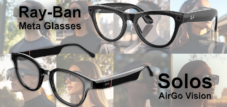Published on: April 14, 2025 / update from: April 14, 2025 - Author: Konrad Wolfenstein
The future of digital reality: How Smart Glasses, AR and XR shape the market
Revolution of the head displays: Different visions of Google, Apple and Co.
The world of intelligent glasses has developed rapidly in recent years. Various technology approaches are currently competing for dominance on the market of portable head displays. This shows a clear differentiation between pure smart glasses with basic functions, AR glasses with an extended representation of reality and XR glasses that enable mixed reality experiences. With each of these concepts, tech giants such as Meta, Google, Apple and Samsung pursue different visions of the digital future-with sometimes overlapping, sometimes very divergent approaches.
Suitable for:
- Driving more securely thanks to smart glasses? Android Auto indicates new function-a head-up display 2.0?
Smart Glasses: The digital everyday companions
Smart glasses are intelligent glasses in its basic form, which are equipped with integrated electronics and sensors. They offer extended functions, but remain very similar to that. In contrast to more complex AR or XR variants, their focus is primarily on practical everyday functions.
Definition and core functionalities
Smart Glasses are essentially “intelligent glasses” with basic digital functions that act as a discrete information indicator. They enable the carrier to consume digital content and interact with them without leaving the real world. The technology integrated in smart glasses typically includes components such as microprocessors, cameras, microphones, small displays and sensors.
Current models and their functions
The Ray-Ban Meta Wayfarer, one of the most popular smart glasses, offers users the opportunity to listen to music, accept calls, take pictures or videos and carry out simple voice commands. A battery charge lasts about four hours. The eyesight of the glasses can be individually adjusted, which means that they can be seamlessly integrated into everyday life.
The Meta Ray-Ban Smart Glasses are especially designed for those who want to “grasp moments of life faster than with the phone and receive AI help, such as when identifying ingredients and finding recipes”.
Other models such as the Amazon Echo Frames (3rd generation) or the Razer Anzu Smart with blue light filters especially for office work show the variety of applications. The Razer Anzu Smart, for example, has an integrated microphone and speaker and can be controlled via the glasses brackets, with a battery life of about five hours.
Primary areas of application
Smart Glasses primarily serve to report information, communication and entertainment. You can show routes, translate texts, play music or call calls, display photos and videos as well as access to AI assistants. The focus is on the support of daily activities without isolating the user from his surroundings.
AR glasses: The expansion of our reality
Augmented reality (AR) glasses go a decisive step further as a simple smart glasses. They expand the real world with digital elements and offer deeper integration of virtual content into the physical environment.
Technological approach and special features
AR glasses blind digital content such as holograms, 3D objects or information directly into the real world. Unlike Smart Glasses, it is not just about the display of information, but also about the actual expansion of physical reality. An essential feature of AR glasses is the use of transparent displays that enable digital content to display directly into the environment, while the real world remains visible.
The concept of “spatial computing” plays a central role in AR glasses-it describes the fusion of digital and physical environments for intuitive interaction. Digital objects can be interacted with the real world and placed in three -dimensional space.
Leading models and their skills
The XReal One is one of the leading AR glasses on the market. It enables access to a virtual large screen and offers advanced functions such as built-in head tracking. An upcoming version, the XReal One Pro, is said to be equipped with even better display technology.
The Viture Pro XR/AR glasses was designed for gaming, streaming and work in the home office. Your virtual display measures impressive 135 inches and offers 120 Hz and 4,000 nits brightness. It is particularly important to emphasize their versatility: "With the right accessories, practically every laptop, every console or cell phone can be connected and, thanks to AR, immerse yourself in the virtual world".
Differences to the conventional smart glasses
In contrast to simple smart glasses, AR glasses offer a much deeper integration of digital content in the physical environment. While smart glasses primarily display information, AR glasses can expand and change the surroundings by virtual objects. They are therefore particularly suitable for more complex applications such as navigation with displayed signs, translation of texts in real time or interactive visualizations of 3D models.
Suitable for:
- AI glasses focus: Can wearables replace smartphones? How to change Wearables industry, medicine and everyday life
XR glasses: The fusion of the worlds
Extended Reality (XR) and Mixed Reality (MR) glasses represent the most progressive approach by combining elements from AR and VR and creating a continuum between these technologies.
The concept of the XR continuum
XR is a generic term for all virtual technologies that include both AR and VR and their mixed forms. “Extended Reality (XR) includes various types of digital interaction”. There is a continuum between the extremes of AR and VR, with mixed reality (MR) located in the overlap area.
In this continuum, XR glasses can “represent and use different forms of expanded reality”. They create immersive experiences in which the user can either immerse themselves in virtual worlds or combine them with the physical world.
Mixed reality: between AR and VR
Mixed reality combines elements of AR and VR technologies by integrating virtual objects into the real world and enables them to interact with the physical environment. In contrast to Reiner AR, MR allows a deeper interaction with virtual objects that naturally merge with the physical environment.
With mixed reality glasses such as the Microsoft Hololens, "the real and virtual dimension can merge". Users experience themselves “physically on the virtual level, because it is possible for them to move three -dimensional objects, edit annotations or to refer notes on objects”.
Technology variants: Pass-Through vs. See-through
There are two basic technological approaches for XR glasses:
- Optical See-Through Displays: With this technology, the displays are transparent and allow the user to look directly through them, while digital content is projected above it. Microsoft Hololens uses this technology.
- Video Pass-Through: With this method, cameras record the real environment and indicate it together with digital content on screens inside the glasses. "It is a 'VR' device, which, however, has a so-called 'pass-through mode' using front cameras.
Flagship models in the XR area
The Apple Vision Pro represents Apple's first entry into the VR/AR market and is positioned as a highly developed mixed reality headset. It is equipped with two micro-OLED displays that provide a resolution of over 4K per eye and support high dynamic range. The Vision Pro costs $ 3,499 and aims at home and work.
Other advanced XR models include the META Quest with Passhrough technology, which enables mixed reality experience.
The technology comparison: differences and overlaps
The three concepts-smart glasses, AR glasses and XR glasses-differ in several essential aspects, but also have overlaps in certain areas.
Design and portability
A significant difference is design and sustainability. Smart glasses are “slim, light and unobtrusive that they can be easily integrated into everyday life”. They are similar to normal glasses and are designed for all -day use.
AR glasses tend to be somewhat larger, but still suitable for everyday use, while XR glasses and VR headsets with a passenthrough function “are significantly larger and more extensive and the eyes fully enclose to create an immersive experience”. Even advanced models such as the Apple Vision Pro are "developed primarily for inpatient use" due to their size and weight.
Representation of the content
The type of presentation varies significantly between the different concepts:
- Smart Glasses typically indicate simple 2D information or project them into a limited area of the field of vision.
- AR glasses use “transparent displays that show digital information such as signs, notifications or translations directly into the area.
- XR glasses with PASSHROUGH technology "rely on cameras that absorb the real world and transfer to high-resolution screens inside". This technology enables impressive mixed reality experiences, but looks less seamless, since the real environment always remains a bit “digital” by the camera.
Application scenarios
The areas of application differ according to the technological skills:
- Smart Glasses are "designed for everyday life to provide light AR functions such as navigation, notifications or interactive overlays". They serve as a discrete expansion of the smartphone for basic information and media reproduction.
- AR glasses aim at applications in which the real world is expanded to include digital elements, such as in city tours or when displaying product information in real time.
- XR glasses, on the other hand, are “powerful devices for immersive applications such as gaming, creative work or virtual meetings”. They are suitable for scenarios that require a deep interaction with virtual objects.
Market development and technology trends
The market for intelligent glasses develops rapidly, with significant innovations and strategic movements of the large technology companies.
Current developments in the tech giants
Google seems to progress in the development of smart glasses with a display. During a TED conference in Vancouver, the company demonstrated the prototype of AI glasses with an integrated screen that offers functions such as live translation and image recognition. This development indicates that Google is preparing for the launch of the first AR glasses with the new Android XR operating system.
Samsung works on “Project Haean”, a smart glasses with a display based on Android XR, which is to be presented by the end of 2025. The company confirmed the development of smart glasses in early 2025 in the course of the presentation of the Galaxy S25.
Meta develops the Ray Ban glasses with an integrated display under the code name “Hyprenova”. According to Bloomberg, this should cost more than $ 1,000 and thus become noticeably more expensive than the previous Ray Ban models. In addition, the “Ray-Ban Meta Smart Glasses with augmented reality display” was announced for the second half of 2025.
Interplay of AR and AI
An important trend is the increasing integration of artificial intelligence in AR glasses. Models such as the Solos Airgo V offer “impressive flexibility in the choice of AI assistant” and allow users to choose between different AI frameworks such as Openaai GPT-4.0, Anthropic's Claude or Google Gemini.
The Ray-Ban Meta Glasses are closely connected to Meta AI, which is based on the LLAMA-2 framework and offers functions such as the detection of sights and the provision of information.
The platform battle: Android XR vs. Proprietary systems
With Android XR, Google has developed a new platform especially for AR and XR devices. This operating system is “a further development of the well-known Android system, but optimized for immersive applications”. It offers developers a stable basis for innovative AR and XR applications and supports a variety of hardware platforms.
With Android XR, Google positions itself as a “driving force behind XR technology and paves the way for even more exciting applications in the coming years”. This platform could be crucial for the standardization and distribution of AR and XR technologies.
Advantages and disadvantages of the different concepts
Each of the three approaches has specific strengths and weaknesses that are relevant for different applications.
Smart Glasses: Practical but limited
Advantages
- Inconspicuous, everyday design similar to normal glasses
- Longer battery life of 4-5 hours
- Comparatively affordable price (from approx. 329 euros for Ray-Ban Meta)
- Easy integration into everyday life without getting used to
Disadvantages
- Very limited AR functionality, more of a “preliminary stage or a first step towards AR/MR”
- Limited field of vision for digital content
- Limited interaction options with virtual objects
AR glasses: Extended reality with compromises
Advantages
- Transparent displays for natural integration of digital content in the environment
- Conservation of the full perception of the real world
- Particularly suitable for navigation, translation and context -related information
- Larger field of vision for digital content compared to Smart Glasses
Disadvantages
- More striking design compared to Smart Glasses
- Technical challenges in the presentation of contrasting AR content
- Higher costs (XReal One for € 549.00)
- Shorter battery life through more energy -intensive displays
XR glasses: Immersive but less suitable for everyday use
Advantages
- Combine the strengths of AR and VR for more versatile applications
- Higher immersion and interactivity with virtual objects
- Power stronger for complex applications such as creative work or gaming
- More precise spatial detection and positioning virtual objects
Disadvantages
- Significantly larger, more striking design
- Significantly higher prices (Apple Vision Pro: $ 3,499)
- Lower everyday suitability due to the size and weight
- In the case of PASSHROUGH technology, less natural perception of the environment
Suitable for:
- Battle of the XR glasses: Differences between Meta Quest 3 and Apple Vision Pro. Which one is better?
Future perspectives: Where does the market develop?
The development of intelligent glasses is at a crucial turning point, with several clear trends that will shape the future of this technology.
Technological convergence
The boundaries between the different concepts begin to blur. "We start to see a hybridization of AR and AI with Metas Orion, which was unveiled at Connect 2024, and the announcement of Android XR, which will have a major impact on smart glasses, but a real mix is still a few years away".
This convergence indicates a future in which intelligent glasses seamlessly integrate both and AI functions and combine the strengths of both technologies.
The potential as a smartphone replacement
XR or Smart Glasses "can combine physical and digital experiences and therefore have the potential to replace the smartphone in a more virtualized world". This vision of a post-smartphone age drives many of the innovations in this area.
Pandemic has accelerated the digital transformation that merges into virtual transformation. In this new era, intelligent glasses could play a central role as a primary interface to the digital world.
Innovative display technologies
The development of new display technologies is crucial for the future of intelligent glasses. Meta relies on “Micro-LED projects in combination with innovative silicon carbide lenses”, while TDK has developed a “full-color laser module (FCLM)”.
Siliconia carbide as a material for the lenses offers several advantages: “Siliconia carbide has a higher number of breakdown than conventional glass and can therefore bundle and break the light more, which enables more precise image display.
The development of portable display technology
The competition of the concepts between smart glasses, AR glasses and XR glasses reflects the dynamic development in the area of portable display technologies. Each approach has its own strengths and serves different applications and user needs.
Smart Glasses with their suitability for everyday use and simple functionality offer a low -threshold entry into the world of portable technology. AR glasses expand our reality and create new opportunities for interaction with digital content. XR glasses merge the physical and virtual world and offer the most inevitable experiences, but are even less suitable for everyday use.
The future will probably bring a convergence of these different approaches, with intelligent glasses that can integrate both AR and AI functions seamlessly and take on more and more tasks of our smartphones. Demos like those of Google and Meta indicate "that the technology has now been miniaturized so far that augmented reality in glasses is now technically feasible".
Ultimately, the decisive difference remains that smart glasses are everyday companions for a natural integration of AR, while XR headsets with AR functions serve primarily as a platform for immersive experiences and complex applications. Both technologies have their strengths, depending on whether we want to expand our real world or leave it behind for a while.
Suitable for:
Your global marketing and business development partner
☑️ Our business language is English or German
☑️ NEW: Correspondence in your national language!
I would be happy to serve you and my team as a personal advisor.
You can contact me by filling out the contact form or simply call me on +49 89 89 674 804 (Munich) . My email address is: wolfenstein ∂ xpert.digital
I'm looking forward to our joint project.















